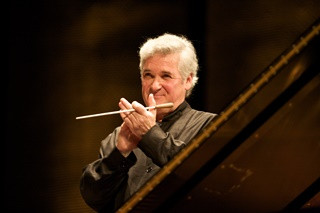|
Back
Alacrity and Confidence Ottawa
Southam Hall, National Arts Centre
09/27/2014 -
Anton Bruckner: ‘Adagio’ from String Quartet in F major
Antonín Dvorák: Serenade in E major for Strings, Op. 22
Wolfgang Amadeus Mozart: Serenade No. 10 in B-flat major, ‘Gran Partita’, K. 370a [361]
National Arts Centre Orchestra, Pinchas Zukerman (conductor)

P. Zukerman (© Kenn Taylor)
The National Arts Centre Orchestra continued its ‘Vienna Festival’ with a unique, indeed extraordinary program which might be described as ‘chamber music for orchestra’ and described as such, from a range of perspectives.
The evening’s first half was strings only, playing Bruckner’s Adagio from his String Quartet in F major, then Dvorák’s Serenade in E major. Pinchas Zukerman conducted and delivered performances replete with luxuriance which beautifully served the more austere, though highly lyrical Bruckner, as well as the more light spirited, though never frivolous Dvorák. Since the orchestra’s debut in 1969 its string section has always been its foundation and it’s no surprise that Zukerman, being an eminent violinist as well as conductor, has maintained this strength. The Bruckner is a wonderful illustration of mid-19th century German composition which matches structure with romanticism. There are echoes of Wagner and foreshadowing of Mahler (especially the Adagietto from Mahler’s Symphony No. 5) and all of this came across with breathtaking subtlety and clarity.
The Dvorák Serenade is another work with roots from diverse times and places---the classicism of Mozart (which Dvorák’s contemporary, Tchaikovsky, similarly encompassed in his own Serenade for Strings) and Bohemian folk music. Again, the performance was a salutary lesson in discreet, multifaceted texture and sonority: the yearning opening Moderato, the more playful Valse and Scherzo, the liquid, almost limpid Larghetto and the quite dramatic Finale.
Following intermission, wind and brass players and a single contrabass player were on stage for Mozart’s Serenade No. 10 (also known as ‘Gran Partita’), a work we don’t hear all that often which however is quintessential Mozart. The Largo introduction for the first movement leads to a vigorous Molto Allegro which shows the composer at his most characteristically jocular. The first Menuetto is delicate and stately. After an Adagio highlighted by a hunting oboe melody, the second Menuetto is again stately, if more formal, almost military. The pastoral Romanze leads to the again jocular Theme and Variations, then to the Finale: Molto Allegro which has a more miniature military dimension (and could be a conspicuous source for some of Tchaikovsky’s ballet and earlier symphonic writing).
The players for the most part navigated the Serenade’s challenges with alacrity and confidence, including frequent and subtle ornamentation. This was a fine conclusion to a unique, very enjoyable evening.
Charles Pope Jr.
|